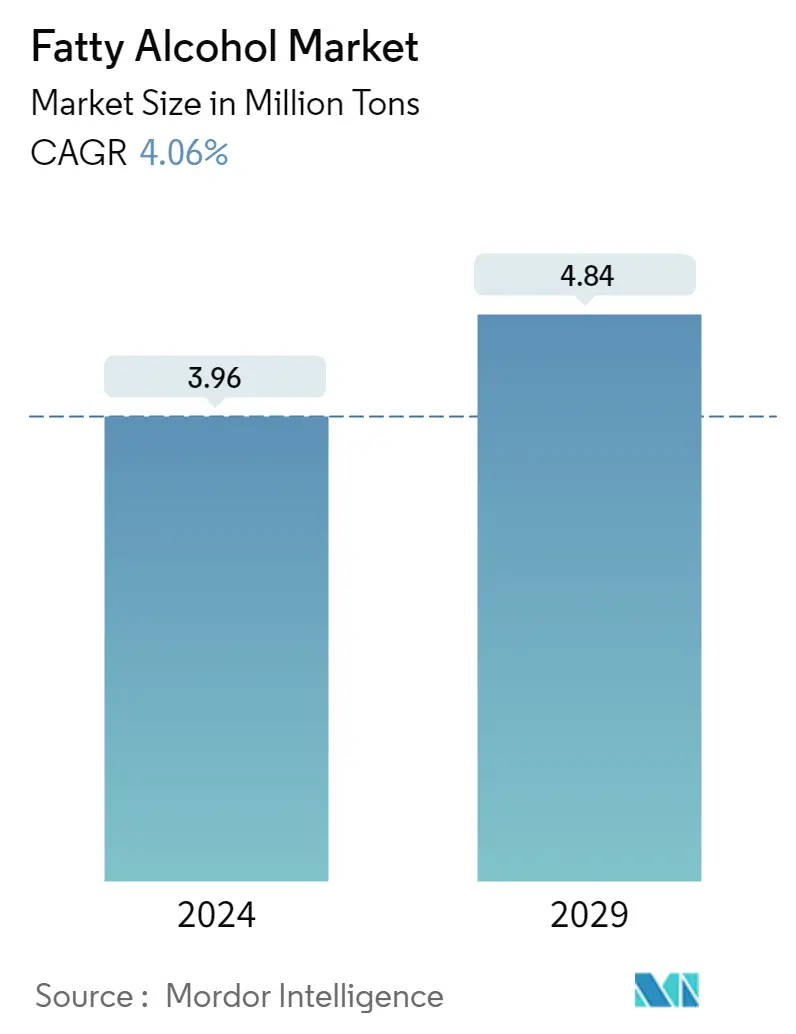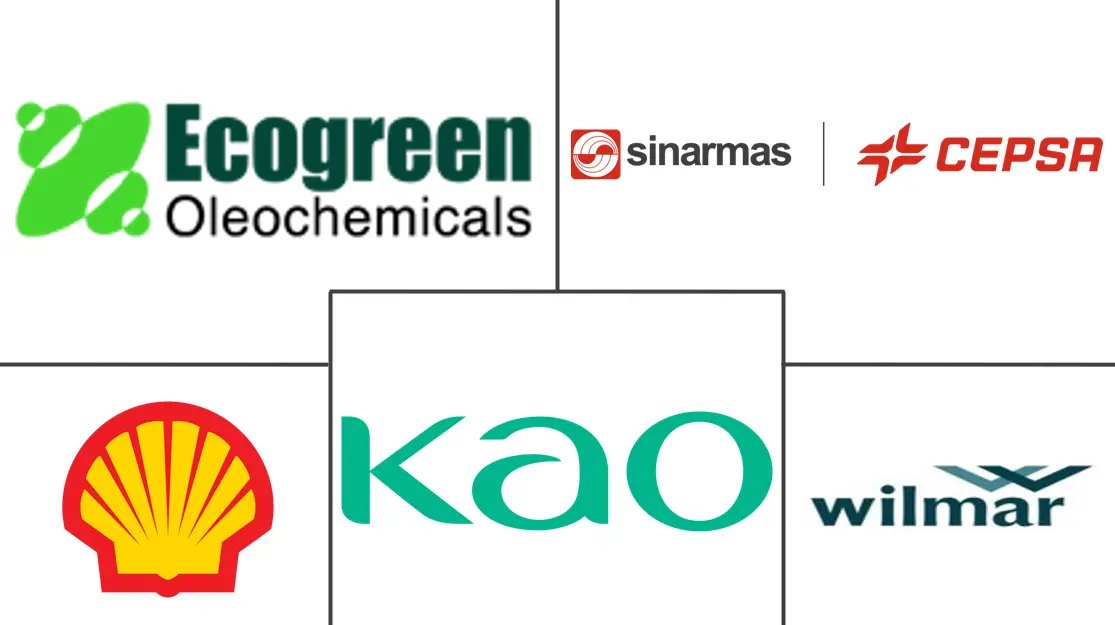Market Size of Fatty Alcohol Industry

| Study Period | 2019 - 2029 |
| Base Year For Estimation | 2023 |
| CAGR (2024 - 2029) | 4.06 % |
| Fastest Growing Market | Asia Pacific |
| Largest Market | Asia Pacific |
| Market Concentration | Low |
Major Players
*Disclaimer: Major Players sorted in no particular order |
Fatty Alcohol Market Analysis
The Fatty Alcohol Market size is estimated at 3.96 Million tons in 2024, and is expected to reach 4.84 Million tons by 2029, growing at a CAGR of 4.06% during the forecast period (2024-2029).
The market was negatively impacted due to COVID-19. Several countries went into lockdown to curb the spread of the pandemic. The shutdown of numerous companies and factories disrupted supply networks worldwide and harmed global production, delivery schedules, and product sales. Currently, the fatty alcohol market has recovered from the impacts of the COVID-19 pandemic and is growing at a significant rate.
- Over the medium term, the growing demand from the pharmaceutical industry and the increasing usage of fatty alcohol in personal care and cosmetics products are expected to be the major driving factors for the market.
- On the flip side, high volatility in raw material prices is likely to pose as a restraint for the market.
- The growing demand for bio-based fatty alcohol products is likely to act as an opportunity for the market in the coming years.
- The Asia-Pacific region accounts for the highest market share, and the region is likely to continue its dominance in the market during the forecast period.
Fatty Alcohol Industry Segmentation
Fatty alcohols are typically high-molecular-weight, straight-chain primary alcohols with as few as 4-6 carbons or as many as 22-26 carbons generated from natural fats and oils. The traditional sources of fatty alcohols have largely been various vegetable oils, which remain a large-scale feedstock. Fatty alcohols are also prepared from petrochemical sources. In the Ziegler process, ethylene is oligomerized using triethylaluminium followed by air oxidation.
The fatty alcohol market is segmented by type, application, and geography. By type, the market is segmented into natural sources and petrochemical sources. By application, the market is segmented into surfactants, pharmaceuticals, lubricants, personal care, foods, and other applications. The report also covers the market size and forecasts for the fatty alcohol market in 15 countries across major regions. For each segment, market sizing and forecasts are done in volume (tons).
| By Type | |
| Natural Sources | |
| Petrochemical Sources |
| By Application | |
| Surfactants | |
| Pharmaceuticals | |
| Lubricants | |
| Personal Care | |
| Foods | |
| Other Applications |
| By Geography | |||||||
| |||||||
| |||||||
| |||||||
| |||||||
|
Fatty Alcohol Market Size Summary
The fatty alcohol market is poised for significant growth over the forecast period, driven by its essential role in various industries such as pharmaceuticals, personal care, and cosmetics. The market has rebounded from the disruptions caused by the COVID-19 pandemic, which had previously impacted global supply chains and production schedules. The increasing demand for fatty alcohols, particularly in the production of detergents and surfactants, is a key factor propelling market expansion. Fatty alcohols, known for their amphipathic properties, are crucial in creating nonionic surfactants used in household cleaning products. The Asia-Pacific region, with its robust industrial base and high consumer demand, particularly in countries like China and India, holds the largest market share and is expected to maintain its dominance.
Despite the promising growth prospects, the market faces challenges such as the volatility in raw material prices, which could hinder its progress. However, the rising interest in bio-based fatty alcohol products presents a significant opportunity for market players. The global fatty alcohol market is characterized by its fragmented nature, with numerous large and medium-scale companies competing for market share. Recent strategic moves, such as acquisitions and partnerships, indicate a trend towards consolidation and expansion in the industry. These developments, coupled with the growing end-user industries in key regions, are expected to further drive the demand for fatty alcohols in the coming years.
Fatty Alcohol Market Size - Table of Contents
-
1. MARKET DYNAMICS
-
1.1 Market Drivers
-
1.1.1 Growing Demand from Pharmaceutical Industry
-
1.1.2 Increasing Usage of Fatty Alcohol in Personal Care and Cosmetics Products
-
-
1.2 Market Restraints
-
1.2.1 High Volatility in Raw Material Prices
-
1.2.2 Other Restraints
-
-
1.3 Industry Value Chain Analysis
-
1.4 Industry Attractiveness - Porter's Five Forces Analysis
-
1.4.1 Threat of New Entrants
-
1.4.2 Bargaining Power of Buyers
-
1.4.3 Bargaining Power of Suppliers
-
1.4.4 Threat of Substitute Products
-
1.4.5 Intensity of Competitive Rivalry
-
-
-
2. MARKET SEGMENTATION (Market Size in Volume)
-
2.1 By Type
-
2.1.1 Natural Sources
-
2.1.2 Petrochemical Sources
-
-
2.2 By Application
-
2.2.1 Surfactants
-
2.2.2 Pharmaceuticals
-
2.2.3 Lubricants
-
2.2.4 Personal Care
-
2.2.5 Foods
-
2.2.6 Other Applications
-
-
2.3 By Geography
-
2.3.1 Asia-Pacific
-
2.3.1.1 China
-
2.3.1.2 India
-
2.3.1.3 Japan
-
2.3.1.4 South Korea
-
2.3.1.5 Rest of Asia-Pacific
-
-
2.3.2 North America
-
2.3.2.1 United States
-
2.3.2.2 Canada
-
2.3.2.3 Mexico
-
-
2.3.3 Europe
-
2.3.3.1 Germany
-
2.3.3.2 United Kingdom
-
2.3.3.3 France
-
2.3.3.4 Italy
-
2.3.3.5 Rest of Europe
-
-
2.3.4 South America
-
2.3.4.1 Brazil
-
2.3.4.2 Argentina
-
2.3.4.3 Rest of South America
-
-
2.3.5 Middle East and Africa
-
2.3.5.1 Saudi Arabia
-
2.3.5.2 South Africa
-
2.3.5.3 Rest of Middle East and Africa
-
-
-
Fatty Alcohol Market Size FAQs
How big is the Fatty Alcohol Market?
The Fatty Alcohol Market size is expected to reach 3.96 million tons in 2024 and grow at a CAGR of 4.06% to reach 4.84 million tons by 2029.
What is the current Fatty Alcohol Market size?
In 2024, the Fatty Alcohol Market size is expected to reach 3.96 million tons.

